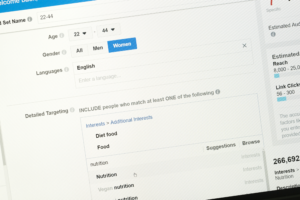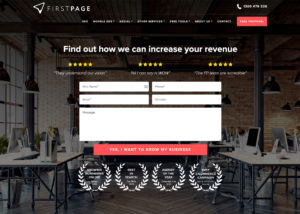How Do Facebook Ads Work? The Science Behind the Technology
With over 2 billion users around the globe, it’s pretty clear that Facebook has become a huge part of daily life. That’s why Facebook is such a valuable part of digital marketing that can make or break a business.
Digital Advertising Today
Before we tell you how Facebook ads work to grow your business, you need to understand how marketing has changed greatly over the years with the rise of digital media.
Once upon a time, businesses mainly had to rely on print and television ads to reach their audience, but that’s now a thing of the past! These days, successful businesses are onto bigger and better things – advertising on social media!
Marketing used to be all about creating campaigns to reach the widest possible audience, and simply crossing our fingers that at least some of it would stick!
Thanks to digital media, marketers and business owners can more precisely target their campaigns by segmenting their audiences, identifying their requirements and finally tailoring their messages for the desired outcome.
Moving beyond a one-size-fits-all approach, social media has drastically changed the way that companies market their products and services – which is where Facebook ads come in.
What Are Facebook Ads?

Facebook ads are a means of online advertising, allowing businesses to target a specific audience with customised ads using Facebook’s ads manager. The platform’s large user base makes Facebook an extremely powerful tool for reaching potential customers and generating leads that convert.
Businesses can use a variety of ad formats and target these ads based on different interests, demographics, and even on and off Facebook activity. The possibilities are virtually endless, so let’s get cracking!
Facebook Ad Formats
Facebook offers five main ad formats. The ads manager lets you choose from an image, video, carousel, slideshow and collection ad format. There’s no hard and fast rule about which ad format is the best – so read on to learn more about the different ad types to help your decision-making.
- Image/Photo ads
Images ads are more eye-catching than text ads, and they can be used to highlight products or services. If you choose an image ad for your campaign, make sure that you choose a powerful ad image that makes your custom audience remember you and your ads.
It’s a good idea to accompany your chosen image with a catchy headline to bring your message home to the targeted Facebook users.
Avoid large chunks of text in your ad copy as it will likely cause your audience network to skim through your message and not take anything in – putting all your Facebook advertising efforts to waste.
- Video ads
Facebook video ads are sometimes considered one of the more engaging ad options, as they can be used to tell a story or showcase a product in action.
For example, if you run a makeup company and wanted to create a Facebook ad campaign for a new lipstick, you could display video ads to show what the model looks like before and after applying the lipstick.
Showing your product in action through videos can add credibility to your brand because potential customers can see what the product can do for them before committing to the purchase.
- Carousel ads
Carousel ads are a type of image ad that allows businesses to showcase multiple products or images within a single ad.
Carousel ads are ideal for showcasing a range of products, telling a story or providing step-by-step instructions about how to use a certain product.
These types of Facebook ads encourage audience engagement – which could help if your campaign objective is to increase brand awareness, for example. The more time a Facebook user spends interacting with your ad, the more opportunity they have to get to know the product or service presented to them.
- Slideshow ads
A slideshow ad is very similar to a carousel ad in form and function. However, while carousel ads can display up to 10 photos or movies through interactive swiping, slideshow ads are simply video ads that compile 2–15 images.
At the end of the day, however, it’s all about quality – not quantity. If the images you choose in your Facebook ad campaign lack cohesiveness, they can do more harm than good to your ad’s performance.
- Collection ads
If you choose collection ads when creating your Facebook campaign, it provides an instant experience that allows Facebook users to interact with and more comprehensively explore your product range.
A collection ad can increase your click-through rate because it exposes your target audience to a number of your products or services, increasing their chances of finding a product or service that resonates with them.
The key takeaway
No matter what ad types you choose for your ad campaigns, ensure that it’s relevant to your audience and product/service promoted, and of course, with your campaign objective.
How Facebook Ads Work – The Process
You might still be wondering how Facebook truly ads work – and that’s completely fine!

The Basics of Creating Facebook ads
There are a few things to keep in mind to create effective Facebook ads.
When you first think of your campaign details, you will need to carefully consider your objective. In the Facebook ads manager, you will have various objectives to choose from.
Common Facebook ad objectives are to generate more traffic and leads from your Facebook page, receive more messages or get more customer contacts.
Get Creative!
Once you know your objective, you can move on to crafting your message. The three creative elements of a Facebook ad are the visuals, text and call to action.
Keep it clear and concise to ensure that you retain the attention of your target audience, enticing them to interact with your ad and business page, ideally resulting in a purchase.
Choosing a Profitable Target Audience
Before selecting a target audience for your Facebook advertising campaign, you should consider the type of consumers who are most frequently drawn to your business, product, or service. Try to determine features that these people share so you can attract lookalike audiences. You could also use this data to create a retargeting ad, which will retarget users who have visited your site, left items in their cart, or clicked on an ad in the past.
When creating Facebook ads, your target audience can be specified by choosing a particular location, age, gender, interests, and even behaviours.
Once you’ve defined your audience, you can decide on ad placements.
Money Talk
Facebook provides a variety of pricing options, so you can control how much you spend on your ad campaign.
Facebook ads are auction-based, meaning that you set a budget for your ad campaign and then bid against other advertisers for placement in the desktop or mobile news feed on Facebook.
The amount you bid, as well as several other factors, determines where your ad appears. The ad rank of your particular Facebook ad could potentially be the difference between failed and successful ads, but it’s important to keep your ad spend within your means to avoid blowing your entire Facebook advertising budget in one go!
Your social media strategy still needs to leave some room for separate campaigns in the future, so consider your lifetime budget.
Selecting Your Facebook Ad Duration
In addition to deciding on a budget, you need to choose an ad campaign duration that complements it. The budget and duration of Facebook ads go hand in hand because the number of days you want your Facebook campaign to run can affect the daily budget.
For example, if your daily budget was $10 for 7 days you would be spending $70 for your campaign in comparison to $140 if your duration was 2 weeks.
Location, Location, Location!
We’re sure that by now you know that Facebook and Instagram are run by Meta – but what does that mean for your business?
In the Facebook ads manager, you can decide whether your Facebook ads appear only on Facebook itself, or Instagram and Facebook both. By allowing your Facebook ads to show on both platforms, it can increase the visibility of your ad campaigns and therefore drive traffic to your landing page.
Reviewing Your Facebook Ad
Finally, review your ad in the Facebook ads manager and submit it for approval. Once it’s been approved, your ad will start running and you can start tracking its performance. By following these simple steps, you can create an effective Facebook ad that will help you achieve your marketing goals.
Tracking Your Progress
Facebook provides several tools to help you track the performance of your ads and make sure that they are successful. You’d hope that your Facebook ads work to achieve the desired purpose, but sometimes changes need to be made.
Google Analytics can also be used in conjunction with Facebook ads manager to track ad data and see if your ad appears to be performing well for the intended demographic.
Facebook ads provide an unparalleled opportunity to reach potential customers through the news feed. And with its highly targeted ads, it’s no wonder that more and more businesses are turning to Facebook ads to grow their business.
How Facebook Ads Work to Grow Your Business

What makes Facebook ads so popular is that they can be extremely targeted to a custom audience. Businesses can show their ads to people who are likely to be interested in what they have to offer. This means that you can waste less money on advertising to people who will never convert into customers.
By creating an advertisement and specifying its target audience, businesses can confidently reach out to potential customers who are most likely to be interested in what they have to offer.
Are Facebook Ads Actually Effective?
Now that you know how Facebook ads work, you might be wondering if they are effective.
The answer is yes – Facebook ads are an incredibly useful tool for promoting products or services and are an essential part of a successful marketing strategy of a business.
With its ability to target custom and lookalike audiences and encourage action beyond a Facebook page, Facebook ads can help your business skyrocket to the top!
Checklist for Effective Facebook Ads
If you want your business to fully reap the benefits of Facebook ads (and we’re sure you do!), it’s important to understand the best practices of Facebook ads.
Relevancy is Key
There’s no point in creating an ad that nobody will be interested in, is there? To ensure that your Facebook ads work, take advantage of the comprehensive audience targeting options in the Facebook ads manager.
Keep It Short and Sweet
When it comes to ad copy, it’s best to get straight to the point. Avoid any unnecessary fluff – you’re trying to build a marketing campaign, not a teddy bear!
Use Eye-Catching Visuals
According to a jaw-dropping new study, your regular Facebook user scrolls through over 100m of content a day on their news feed!
If your photo ads don’t instantly grab the attention of your audience, they’ll scroll past quicker than you can say “vegemite!”
Use an Effective Call to Action
Unfortunately, people aren’t built to read minds.
This is why the call to action of your Facebook post must indicate what you want your target audience to do – from signing up for your company’s mailing list to following the link to your landing page (and hopefully giving you a sale!).
Optimise For Both Mobile and Desktop
When you run ads, you’ll never know if your targeted audience will see them on a mobile device or desktop, so it’s an absolute must to optimise your ads for both to ensure a seamless experience for everyone.
Reach Out to the Pros
By now you can probably see how much value a strong Facebook ad campaign can bring to your business. If you want to create a new ad campaign on Facebook that is sure to knock it out of the park, you’ve come to the right place.
Contact First Page today via our easy web form or call 1300 479 3226. Together, we can achieve great things!















